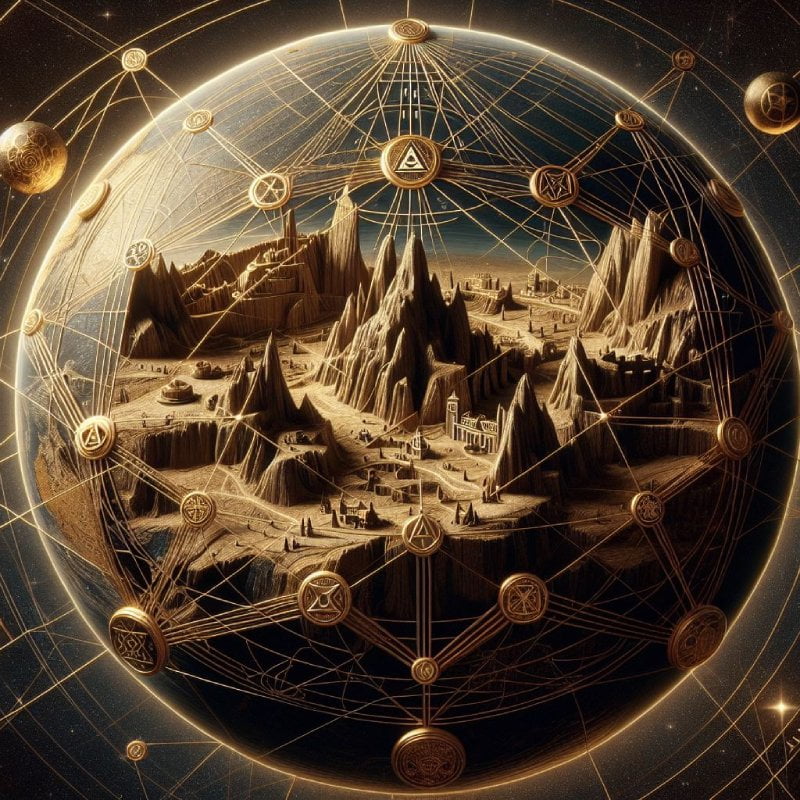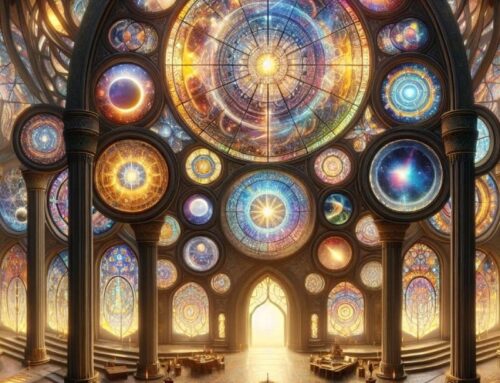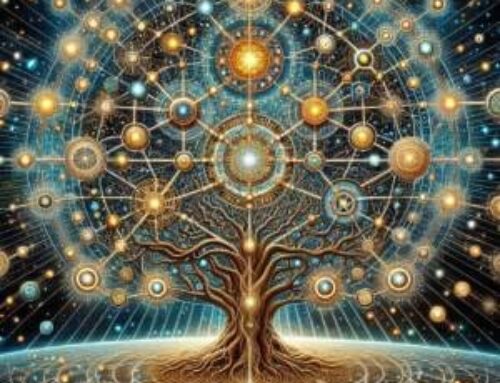Contents
Introduction to a History of Gnosticism
Gnosticism, a mystical tradition that thrived in the early centuries of the Common Era, remains a profound source of spiritual insight and esoteric wisdom. Picture the early Gnostics, seekers of divine knowledge, navigating a world filled with religious fervor and philosophical debates. They believed that within each human resides a divine spark, trapped in the material world, yearning for liberation. This quest for hidden wisdom and enlightenment forms the crux of Gnosticism, a passage that transcends mere historical study and touches the very essence of human spirituality. A history of Gnosticism reveals the profound influence of ancient philosophical and religious traditions. Gnosticism derives from the Greek word “gnosis,” meaning knowledge, but not just any knowledge.

Know that what sees in thee and hears is the Lord’s Word (Logos); but Mind is Father−God. Not separate are they the one from other; just in their union [rather] is it Life consists (1).
It is an intimate, esoteric understanding of the divine, a knowledge that promises to awaken the soul and reconnect it with its celestial origins. The Gnostics viewed the material world as a flawed creation, a shadow of a higher, perfect reality. To them, the path to salvation lay in acquiring gnosis—secret, spiritual knowledge that would free the divine essence within and guide it back to its true home. The history of Gnosticism is intricately linked with various religious and philosophical traditions, including early Christianity, Kabbalah, and Hermeticism. Each of these traditions contributed to the rich tapestry of Gnostic thought.
Ancient Influences and Early Development
Exploring the history of Gnosticism reveals a rich interplay between hidden knowledge and spiritual enlightenment. Gnosticism is deeply intertwined with various ancient religious and philosophical traditions. These influences provided fertile ground for Gnostic ideas to flourish, creating a unique spiritual path focused on discovering hidden wisdom and achieving personal enlightenment.
Enlightenment is the ability to use one’s own understanding without another’s guidance, resulting in man’s emergence from self-imposed nonage (2).
Hellenistic Philosophical Roots
The thought of the Gnostics was significantly shaped by Hellenistic philosophy, particularly Platonism. Platonic dualism, which posits a distinction between the material and ideal realms, resonated deeply with Gnostic beliefs. Gnostics saw the material world as an imperfect reflection of a higher spiritual reality. Central to their cosmology is the Demiurge, a subordinate creator deity often depicted as ignorant or malevolent, entrapping the divine spark within the physical world.
Early Christian Context
Early Christianity added another critical layer to Gnostic foundations. In the initial centuries of the Common Era, various interpretations of Christian doctrine emerged, and Gnostic Christianity was one of these interpretations. Gnostic texts, such as those found in the Nag Hammadi library, provide a unique perspective on Christian teachings. They often depict Jesus as a revealer of hidden knowledge, aiming to awaken the divine spark within humanity and guide souls back to the divine pleroma, or fullness.
Human Soul and the Divine: The human soul is seen as a microcosm of the divine structure (3).
Jewish Mystical Traditions
Jewish mystical traditions, particularly those in Kabbalah, also played a crucial role in Gnosticism’s development. The Gnostic concept of divine emanations parallels the Kabbalistic idea of the Sephirot, the ten attributes through which the Infinite reveals itself and continuously creates both the physical and metaphysical realms. Both traditions emphasize hidden knowledge and the spiritual ascent of the soul, which are central themes in Gnostic thought.
The Sephiroth: Ten emanations represent the process of creation and the nature of the divine, forming a tree of life structure (4).
Core Beliefs and Practices of Gnosticism
A history of Gnosticism reveals a distinctive cosmological view that contrasts the material and spiritual worlds. Gnostics perceive the material world as a flawed creation, crafted by the Demiurge, a lesser deity who is often seen as ignorant or malevolent. This being traps the divine spark within the physical realm. In stark contrast, the true God, or Monad, resides in a higher, perfect realm. The ultimate aim in Gnostic belief is to transcend the material world and reunite with this divine source through gnosis, or esoteric knowledge.
The Divine Spark and Gnosis
A history of Gnosticism shows how the quest for gnosis shaped early Christian and mystical Jewish thought. Central to Gnostic belief is the concept of the divine spark, a fragment of the divine trapped within each person. This spark must be awakened through gnosis, which is not just intellectual knowledge but a profound, inner enlightenment that reveals the true nature of reality and the divine. Gnosis involves a journey of self-discovery and spiritual awakening, often guided by a Gnostic teacher or through direct mystical experiences.
Rituals and Spiritual Practices
Gnostic rituals and spiritual practices are designed to awaken the divine spark and attain gnosis. These practices include meditation, prayer, and ascetic disciplines aimed at purifying the soul and detaching from the material world. One key ritual is the initiation ceremony, symbolizing the candidate’s spiritual rebirth and entry into the Gnostic community. Initiations often involve complex rites with symbolic acts, invocations, and sacred texts.
Magic initiation constitutes a true royalty; because also the great art of the magi is characterized by all adepts as the Royal Art, as the Holy Kingdom — Sanctum Regnum (5).
The Role of Sophia and the Feminine Divine
Sophia, meaning Wisdom, is a crucial figure in Gnostic cosmology. She represents the divine emanation and is central to the cosmic creation and redemption narrative. Sophia’s descent into the material world and her subsequent redemption mirror the Gnostic seeker’s journey. This reverence for Sophia highlights the feminine aspect of the divine, a stark contrast to the patriarchal structures of other contemporary religious traditions.
Hermetic and Kabbalistic Traditions
The development of traditions has a history, within Gnosticism. When examining the connection between Gnosticism and Kabbalah we discover an exchange of wisdom and hidden knowledge. Both traditions highlight the importance of seeking truths and exploring the depths within oneself (6).
Connecting the heavens and earth Kabbalahs belief in emanations represented by the Sephiroth on the Tree of Life aligns closely with cosmology, which depicts layered spiritual planes (7). The concept of Tzimtzum in Kabbalah, where divine contraction allows for creation mirrors the Gnostic perspective that views the material world as a creation by the Demiurge.
Hermeticism, attributed to Hermes Trismegistus shares with Gnosticism an appreciation for how the larger universe mirrors our inner selves. The Hermetic principle “As above below” resonates with teachings about how interconnected spiritual and material realms are. Texts like “Corpus Hermeticum” or “Kybalion” provide a foundation that complements beliefs by emphasizing gnosis as a path to spiritual enlightenment and transformation.
By exploring these connections we not trace the development of Gnostic ideas but also recognize their lasting impact, on contemporary spiritual practices.The impact of Kabbalah, on Gnosticism enhanced its understanding of the universe and beliefs about origins and cycles. Both Gnosticism and Kabbalah stress the aspects revealing their intertwined exploration of knowledge. The influence of Hermeticism, on rituals regarding alchemy underscores the common pursuit of unity and personal evolution in both belief systems.
Conclusion
The history of Gnosticism takes us on a journey, through wisdom traditions that intertwine to form a tapestry of spiritual enlightenment. Gnosticisms focus on knowledge and the divine spark within has deeply influenced Hermetic traditions leaving a lasting impact that resonates even today. By exploring these connections we uncover not the evolution of Gnostic thought over time but its profound influence on contemporary spiritual practices. The fundamental tenets of Gnosticism—such as seeking gnosis awakening the spark and transcending the material world—continue to motivate those in search of truths.
These teachings emphasize the timeless pursuit of enlightenment and self discovery encouraging us to look beyond surface level truths and delve into realms of knowledge. As we reflect on this narrative we come to understand that the journey toward wisdom and enlightenment is not confined to the past; it is an exploration accessible, to all. For those intrigued by the teachings of Gnosticism and seeking a deeper understanding, the Hermetic Academy offers unparalleled opportunities for study and spiritual growth.
Engaging with the Hermetic Academy provides access to comprehensive courses and guided meditations that delve into the core principles of Gnosticism, Kabbalah, and Hermeticism.
FAQ – A History of Gnosticism
1. What are the Key Beliefs of Gnosticism?
A history of Gnosticism reveals core beliefs centered on gnosis, or esoteric knowledge, as the path to enlightenment. Gnostics view the material world as a flawed creation of the Demiurge, a lesser deity, and believe in a higher, perfect realm presided over by the Monad. The divine spark within each person must be awakened through gnosis to reunite with the divine source. This pursuit of inner knowledge and spiritual awakening is central to Gnostic thought.
2. What is the Role of Sophia in Gnostic Thought?
In Gnostic cosmology, Sophia (Wisdom) is a pivotal figure representing a divine emanation that becomes trapped in the material world. Her journey and redemption symbolize the Gnostic quest for enlightenment and the return to the divine fullness. Sophia’s story underscores the importance of divine wisdom and the feminine aspect of the divine. Her fall and subsequent restoration mirror the human soul’s journey from ignorance to enlightenment.
3. Where Can One Study Gnosticism In-depth?
To study Gnosticism and related esoteric traditions, the Hermetic Academy is an excellent resource. The Academy offers online courses and guided meditations that delve into Gnostic teachings, initiations, Kabbalah, and Hermeticism. Engaging with the Hermetic Academy provides an opportunity to explore these ancient teachings deeply and join a community of like-minded seekers.
4. What Are Some Important Gnostic Practices?
Key practices in Gnosticism include meditation, prayer, and ascetic disciplines aimed at purifying the soul and awakening the divine spark within. Initiation rituals, symbolizing spiritual rebirth and entry into the Gnostic community, are also crucial. These practices facilitate the attainment of gnosis, leading to a deeper understanding of the divine and the cosmos. Engaging with a history of Gnosticism offers a profound insight into its mystical teachings and transformative practices.
References:
(1) Ficino, M. (1471). Corpus Hermeticum. Florenz.
(2) Kant, I. (2015). What is Enlightenment. https://doi.org/10.1017/9781787440609.002.
(3) Mathers, S. L. M. (1887). The Kabbalah Unveiled. London.
(4) Mathers, S. L. M. (1887). The Kabbalah Unveiled. London.
(5) Eliphas, L. (1854). Dogme et Rituel de la Haute Magie. Paris.
(6) Rubenstein, E. (2023). Magic: The Legacy of the Rosicrucians. Hermetic World, Paphos.
(7) Rubenstein, E. (2020). The Tree of Life: The Kabbalah of Immortality. Hermetic World, Paphos.





